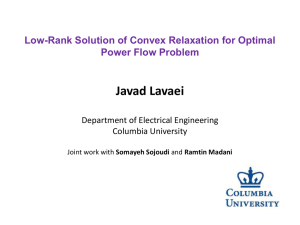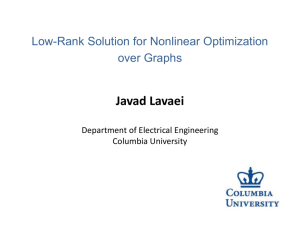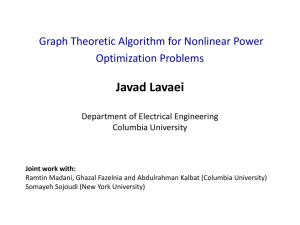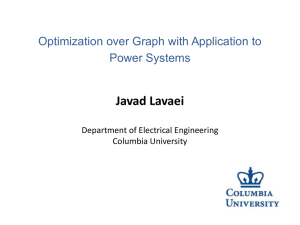Graph-Theoretic Algorithm for Arbitrary Polynomial
advertisement
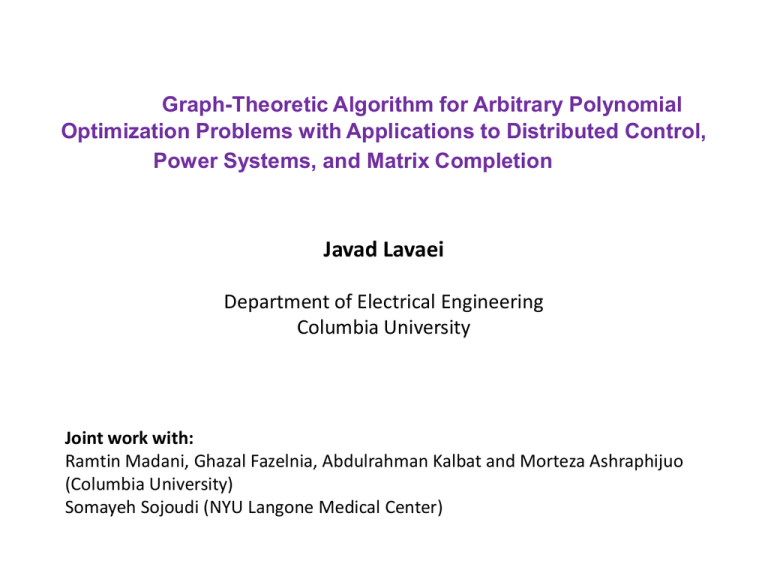
Graph-Theoretic Algorithm for Arbitrary Polynomial Optimization Problems with Applications to Distributed Control, Power Systems, and Matrix Completion Javad Lavaei Department of Electrical Engineering Columbia University Joint work with: Ramtin Madani, Ghazal Fazelnia, Abdulrahman Kalbat and Morteza Ashraphijuo (Columbia University) Somayeh Sojoudi (NYU Langone Medical Center) Outline Theory: Convex relaxation Application 1: Optimization for power networks Application 2: Optimal decentralized control Implementation: High-performance solver handling 1B variables Theory: General polynomial optimization Application: Matrix completion Javad Lavaei, Columbia University Penalized Semidefinite Programming (SDP) Relaxation Exactness of SDP relaxation: Existence of a rank-1 solution Implies finding a global solution Javad Lavaei, Columbia University 2 Sparsity Graph Example: 1 Javad Lavaei, Columbia University 2 ... n 3 Treewidth Tree decomposition Vertices Bags of vertices Treewidth of graph: The smallest width of all tree decompositions -Rank of W at optimality ≤ Treewidth +1 - How to find it? (answered later) Javad Lavaei, Columbia University 4 Outline Theory: Convex relaxation Application 1: Optimization for power networks Application 2: Optimal decentralized control Implementation: High-performance solver handling 1B variables Theory: General polynomial optimization Application: Matrix completion Javad Lavaei, Columbia University Optimization for Power Systems Optimization: Optimal power flow (OPF) Security-constrained OPF State estimation Network reconfiguration Unit commitment Dynamic energy management Issue of non-convexity: Discrete parameters Nonlinearity in continuous variables Challenge: ~90% of decisions are made in day ahead and ~10% are updated iteratively during the day so a local solution remains throughout the day. Cost local global Production Javad Lavaei, Columbia University 6 Contingency Analysis Contingency G8# 37# G10# 25# 26# 29# 28# 30# Contingency Analysis: 27# 2# Assume a line is disconnected. 18# 38# 17# G9# 24# 1# Many generators cannot change productions quickly. The flows over other lines would increase. G6# 3# 16# 15# G1# 39# 22# 21# 14# 4# This triggers a cascading failure. 35# 5# 6# 12# 23# 19# 7# 13# Secure operation: Design an operating point such that the 20# 36# 11# 8# 31# 10# 34# 33# G7# 9# network survives under certain line or generator outages. G2# 32# G5# G3# G4# Limited correction by a generator Challenge 1: Number of constraints is prohibitive (our project with Ross Baldick proposes a new technique to address this). Challenge 2: How to find the best operating point given the nonlinearity of the problem? Javad Lavaei, Columbia University 8 Security-Constrained Optimal Power Flow (SCOPF) Cost for pre-contingency case Power flow equations for pre- and post- contingencies Physical and network limits for pre- and post- contingencies Preventive and corrective actions Javad Lavaei, Columbia University 9 Power Networks What graph is important for SCOPF? Sparsity graph: Disjoint union of pre- and post contingency graphs: Pre-contingency Contingency 1 Contingency 2 Observation: treewidth of sparsity graph of SCOPF = treewidth of power network Treewidth: IEEE 300 bus: 6, Polish 3120 ≤ 24, New York State ≤ 40. Javad Lavaei, Columbia University 10 Decomposed SDP 0 0 0 Decomposed SDP Full-scale SDP Javad Lavaei, Columbia University 5 Power Networks Decomposed relaxed SCOPF: SDP problem with small-sized constraints 0, 0, 0 Reduction of the number of variables for a Polish system from ~9,000,000 to ~90K. Result: Rank of W at optimality ≤ Treewidth +1 Stronger Result: Rank of W at optimality ≤ maximum rank of bags By-product: Lines of network in not-rank-1 bags make SDP fail. Penalized SDP: Penalize the loss over problematic lines Javad Lavaei, Columbia University 11 Example 1: Performance of penalized relaxed OPF on IEEE and Polish systems: Javad Lavaei, Columbia University 12 Example 2: Performance of penalized relaxed OPF on Bukhsh’s examples: http://www.maths.ed.ac.uk/OptEnergy/LocalOpt/ Javad Lavaei, Columbia University 13 Example 3: New England 39 bus system under 10 contingencies: IEEE 300 bus system under 1 contingency corresponding to 3 outages: Javad Lavaei, Columbia University 14 Outline Theory: Convex relaxation Application 1: Optimization for power networks Application 2: Optimal decentralized control Implementation: High-performance solver handling 1B variables Theory: General polynomial optimization Application: Matrix completion Javad Lavaei, Columbia University Motivation Computational challenges arising in the control of real-world systems: Communication networks Electrical power systems Aerospace systems Large-space flexible structures Traffic systems Wireless sensor networks Various multi-agent systems Decentralized controller: A group of isolated local controllers Distributed controller: Partially interacting local controllers Javad Lavaei, Columbia University 15 Optimal Distributed control (ODC) Stochastic ODC: Find a structured control for the system: disturbance noise to minimize the cost functional: Finite-horizon ODC: Deterministic system with the objective: Infinite-horizon ODC: Terminal time equal to infinity. Javad Lavaei, Columbia University 16 Motivation: Maximum Penetration of Renewable Energy 39-Bus New England System Four Communication Topologies Javad Lavaei, Columbia University 17 Motivation: Maximum Penetration of Renewable Energy Assumption: Every generator has access to the rotor angle and frequency of its neighbors (if any). Problem: Design a near-global distributed controller for adjusting the mechanical power We solve three ODC problems for various values of alpha (gain) and sigma (noise). Javad Lavaei, Columbia University 18 Two Formulations of SODC SODC: Convex Reformulated SODC: Non-convex (NP-hard) Convex Non-convex but quadratic Javad Lavaei, Columbia University 19 Quadratic Formulation in Static Case SDP relaxation for SODC: W Theorem: W has rank 1, 2, or 3 at optimality for finite-horizon ODC, infinite-horizon ODC, and SODC. Lyapunov domain Time domain Javad Lavaei, Columbia University 20 Computationally-Cheap SDP Relaxation Dimension of SDP variable = O(n2) Is lower bound tight enough? Can penalize the trace of W in the objective to make it penalized SDP. Goal: Design a new SDP relaxation such that: Dimension of SDP variable = O(n) The entries of W are automatically penalized in the problem. Javad Lavaei, Columbia University 21 First Stage of SDP Relaxation Automatic penalty of the trace of W Lyapunov Inversion of variables Exactness: Rank n Direct and two-hop pattern Javad Lavaei, Columbia University 22 Two-Stage SDP Relaxation Stage 1: Solve SDP relaxation. Stage 2: Recover a near-global controller. Direct Method: Read off the controller from the SDP solution. Indirect Method: Read off G from the SDP solution and solve a convex program. ϒ helps to make the problem feasible, but it’s penalized to keep its value low. Javad Lavaei, Columbia University 23 Mass-Spring System Mass-spring system: Goal: Design two constrained controllers for 10 masses. Solution: (under various level of measurement noise) Javad Lavaei, Columbia University 24 Outline Theory: Convex relaxation Application 1: Optimization for power networks Application 2: Optimal decentralized control Implementation: High-performance solver handling 1B variables Theory: General polynomial optimization Application: Matrix completion Javad Lavaei, Columbia University Low-Complex Algorithm for Sparse SDP Slides for this section are removed. Javad Lavaei, Columbia University 25 Outline Theory: Convex relaxation Application 1: Optimization for power networks Application 2: Optimal decentralized control Implementation: High-performance solver handling 1B variables Theory: General polynomial optimization Application: Matrix completion Javad Lavaei, Columbia University Polynomial Optimization Vertex Duplication Procedure: Edge Elimination Procedure: This gives rise to a sparse QCQP with a sparse graph. The treewidth can be reduced to 1. Theorem: Every polynomial optimization has a QCQP formulation whose SDP relaxation has a solution with rank 1 or 2. Javad Lavaei, Columbia University 28 Outline Theory: Convex relaxation Application 1: Optimization for power networks Application 2: Optimal decentralized control Implementation: High-performance solver handling 1B variables Theory: General polynomial optimization Application: Matrix completion Javad Lavaei, Columbia University Matrix Completion Matrix completion: Fill a partially know matrix to a low-rank matrix (PSD or not PSD) x1 ? ? ? ? x2 x3 x4 x5 x6 x7 x8 0 x9 x10 x11 There are Minimize an arbitrary nonzero sum of X entries to get a rank-1 solution. rank-1 solutions. Javad Lavaei, Columbia University 29 Matrix Completion x1 x2 ? ? ? ? ? ? x3 x4 x5 x6 0 x7 x8 x9 x10 Minimize a nonzero sum of X entries if all blocks are nonsingular and square. Javad Lavaei, Columbia University 30 Matrix Completion ? ? 0 0 x1 x2 x3 x4 x5 x6 x7 x8 u1 u2 u3 u4 Minimize a nonzero sum of X entries by choosing U’s to be 1. General theory based on msr, OS, and treewidth for a general non-block case. Form a penalized SDP or nuclear-norm minimization to find a low-rank solution. Javad Lavaei, Columbia University 31 Conclusions Theory: Low-rank optimization Applications: Power, Control, nonlinear optimization,… Implementation: High-performance solver handling 1B variables Two of our solvers posted online and another one is forthcoming. Collaboration with industry for demonstration on real data. Javad Lavaei, Columbia University 32
